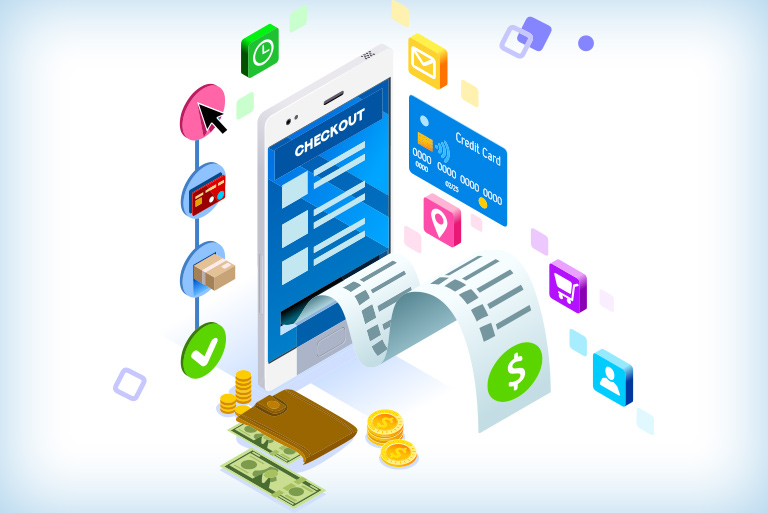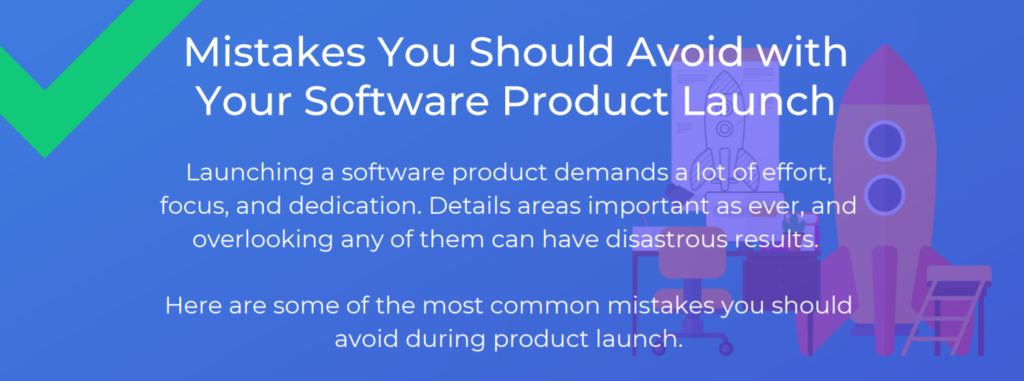Ideally, the launch of a software/SaaS product should be the coronation of the enormous amount of effort (and expenses) dedicated by a company to the development of a new product, meant to help it gain some terrain over its competition.
Unfortunately, things do not always go smoothly, and mistakes are sometimes made throughout product development stages. Rumor has it that “to err is human.” Yet, errors made when launching or preparing to launch a software product can cost dearly. Any aspect that was neglected or treated superficially can have significantly negative consequences.
As a product manager or developer, you probably already have the implementation steps and project workflows mapped out from the start. Mistakes can creep in nonetheless, however, particularly in fast-moving business setups such as startups. Whether it’s from oversight, failure to check with the right stakeholders, lack of experience, working with untested hypotheses, or even fatigue, errors in product launch can end up costing you several months of work.
How to effectively launch a new software product then?
Instead of running the risk of having to head back to the drawing board, follow our primer on the most common mistakes made during product launch, learn from others’ mistakes, establish a failsafe launch review process and, ultimately, an effective product launch.
While we’re not going to focus on technical tips here, launch initiatives have their routes in all stages of the product development process, so we’ve bucketed our list of mistakes into these stages: Development; Go-to-Market; Systems and Finance; Sales and Support, and Feedback.
Read all of the material if you’re just now setting off on your product journey, or browse to the section that fits your product’s current stage.
Stage: Development
It comes as no surprise that most product mistakes occur in this stage. And why wouldn’t it be so? As an expert in the field where you’re developing a product, you assume you have a firm grip on the category, right? But when faced with tight deadlines or expedited flows, even the most prestigious of experts aren’t immune to error-making. Be watchful of the following mistakes or fallacies during the development stage.
1. Failure to perform accurate, thorough market research
It is imperative that you find out as early and as accurately as possible what segment of the market your software will be dedicated to, what needs there are on that particular segment and how you can meet them, what prospective customers expect to get, how other key influencers on the market view the product you’re envisaging, etc.

Market research is further split into two varieties: primary and secondary. You can use either one type of research, or a combination of both.
Keep in mind that it’s the market that dictates your product and, for your SaaS product to be successful, you must find the right product-market fit. One of the best approaches to address market needs appropriately is to create buyer personas during the development stage. To effectively sell to your audience, you first need to know whom you are talking to. Talk to your target audience and ask them if they would buy your product. I heard an entrepreneur once say that this question is a measure for success. If everyone in your target audience say they WOULD buy your product, then it stands a chance in the market. If you hear “maybe” often, either there isn’t a real need for the product, or there are many other competitors in the market, in which case you need to think hard about your differentiators.
2. Not testing the product yourself
You have to put yourself in the customer’s shoes. See how you feel when you use the software. Does it respond well to commands? Does it answer your needs?

There are many things that you need to remember during the testing process and this is a great article that offers helpful tips, straight from the experts.
Stage: Go-to-Market
An old saying in the business world goes something like this: If you’re not even a bit embarrassed when launching a new product, then you waited too long. Timing concerns aside, the go-to-market stage is often witness to entrepreneurs’ mistakes, primarily those related to how they assembled the product mix. This is the stage when the product’s positioning is set, when pricing, promotions, and marketing plans take shape, so any errors that make their way here will haunt your product until a new version of it is launched. Be apprehensive and pay attention to the following Don’ts:
3. Not dedicating enough time and resources for planning and executing a marketing strategy
It is important to give yourself enough time to plan ahead. You must be able to see into the future up to the moment when the product will be launched and establish a series of steps that you must go through prior to the launch itself. Such steps typically include:
- Thoroughly investigating the market and attempting to find out where you stand against your competitors. Analyze everything, including their messaging and positioning.
- Preparing all the P’s: Product (packaging), Pricing, Promotion (content, newsletters, advertising campaigns, information that will go to the media, like press releases, and so on), Place (all channels, and especially digital).
A recommended approach, if the budget allows it, would be to hire professionals who will handle all the process before and during the launch of your software. There is a lot of extra work that your team may not have the bandwidth to handle. And even if you manage the launch in-house, be prepared to provide that team with all the data and support that they need.
4. Not being realistic about the expenses implied by such an event
The budget must be well-thought-out. Be realistic when assessing the costs of your product launch. If you don’t plan everything well enough, you could end up spending much more than originally predicted. Most of the time, you WILL spend more than originally predicted, so it is even better to have a budget for unforeseen situations; preventing is better that facing.

5. Failure to pre-launch or to announce your software’s launching
Don’t just organize the launching event, and, when that day comes, expect it to be all peachy. It won’t, unless you’ve created awareness about your new software some time in advance. Let your prospective customers know that you’re going to have a software product launch through several channels: by newsletters (you will need to build a database of prospects well in advance), through your website and blog, via social, via your influencer friends, via your network, or even advertising.
Tell them a few things about the new product, but not too much so as to spoil the surprise, just enough to capture their interest. Make sure you have a demo available so that they can see what it will be about.
6. Launch event timing mistakes
Choosing the right launch date depends on your audience and your product – if it is a B2B product, it will have to be a weekday (not Friday!), and to not clash with any major event in your industry. If it is a B2C product, such as a holiday or a wedding planner, most experts say that it is preferable to choose a day when most of the people you target are free, such as weekends. Also, it’s best not to choose a day that also corresponds to a significant national or religious holiday.
Don’t neglect the time of day when the launch is scheduled. Make sure it’s not too early or too late in the day, to best capture your audience’s attention. If you have a global audience, try to target it according to the time zone, and if that’s not possible, pick your biggest geography and optimize the timing for that.
Once you have a date picked, stick to it. If you’re going for a physical event, be sure to announce it at least two to three weeks in advance. Even if you are planning an informal event, such as drinks at a bar, or even if the setup is smaller in scope, such as a business lunch, let your audience know about it in a timely manner so that they can make arrangements and clear their agendas for the scheduled date.
Stage: Systems
Most launches have us concerned about the overall launch experience, and about press reactions or user openness to our offering. We often fail to think of our backend systems, and how these can make or break the experience offered by the new product. Of all aspects related to your system’s architecture, don’t be that developer or entrepreneur who makes either of these two rookie mistakes:
7. Failing to scale your infrastructure before launch
Developing in the cloud generally allows us the luxury of forgetting about our infrastructure and virtual machines completely. But, despite current solutions’ scalability, any launch and any marketing campaign should be prefaced by an infrastructure review and resource upgrade. Get your systems team to test just how much traffic and how many processes your current solution can take.
If you’ve efficiently announced the launch, be prepared for an influx of traffic – be it tenfold or twentyfold the normal values, scale before and don’t let server load rain on your big day.
Stage: Sales and Support
Depending on the type of software product you are selling, you will have different sales strategies and programs in place. Some of the issues flagged below might help to some extent, for any variant.
8. Not setting up the proper product billing features
Whether you’re launching a freemium product, a subscription-based service, or a perpetual digital good, ensure all billing features are live and functional on your site/in-app. Be sure to review user account creation processes, onboarding in general, financial data collection, and how each of these translates into user notifications and touchpoints. Pay special attention to the payment particularities of each of the regions in which you’re launching, ensuring users’ preferred payment methods in that country are supported by your product.

If you’re considering using an established payment solution for your newly developed software product, do set up the payment system several weeks prior to launch, to accommodate enough time for activation and all necessary tests.
9. Not provisioning for client success
Client success is the art of being useful and relevant when your user needs you to be. Ensure that your service teams are fully trained before the launch itself and that they are all well-versed in the most common user scenarios. Provide your team with the necessary support materials and recheck the functionality of all client-facing channels.
It’s inevitable that users will reach out to your brand after launch and your goal now is to make a memorable, pleasant experience with each new interaction.
10. Failing to get your partners aboard for the launch
A new product launch will be that much more successful if your efforts are doubled by those of your partners. In the rush to get to market, entrepreneurs often fail to get their partners onboard for their new market release, which, as you would guess, negatively impacts the total reach of the launch.
Don’t miss out on new product opportunities by communicating your upcoming launch, in a timely manner, with your entire partner network – whether they are journalists and press, business partners, or affiliate connections. Ensure that partners have the right resources to support your launch – texts, presentations and product descriptions, branded visuals and any videos, product sheets or FAQs you may have produced for the new star in your portfolio – and nudge them towards sharing them within their networks.
Stage: Feedback
Any launch, be it a soft launch or an all-in event, offers the invaluable opportunity to get real-life feedback that could help you develop a more stable 2.0 version of the product. After the champagne toasts and the press monitoring have concluded, remember to take the time to ask for feedback, from internal teams and from users, and to review it carefully.
11. Not analyzing the feedback you get on the product version launched
Whether you’ve released a beta version of your software or a full-spec product, actively encourage potential users/customers to let you know what they think about it, and make sure you are open-minded and prepared to receive a lot of criticism. Look at it constructively, and don’t take it personally.
Even if some comments will be harsh, keep in mind that most of them will help you notice the flaws of your software and thus allow you to correct them in future installments.

Some ways to get feedback are:
- Feedback survey
- Contact form
- When uninstalling software (the user is asked for the reasons for uninstalling the program)
- Support forum
- Testimonials, etc.
Apart from your customers’ reviews, take the time to analyze the launch event with your internal teams as well, writing down all lessons learned and any useful checklists for future product relaunches.
Conclusion
Launching a software product demands a lot of effort, focus, and dedication. Details are as important as ever, and overlooking any of them can have disastrous results.
Really consider if you have the resources (human and financial) and the time to take care of everything yourself. It may be far better to make an effort and spend some money to work with a specialized company that will take care of everything for you. Think of it as an investment, not as expenses. What you give now can and will return to you eventually. Take into account the fact that such companies have the experience and the know-how for such events, and after all, the possibility of something going wrong decreasing significantly.
Finally, and perhaps most importantly, make sure you dedicate a significant amount of time to planning the launch of your new product. The key is to be patient, as it may actually take more time that initially estimated to have the software ready for launch.
For a visual overview, check out the dedicated infographic.






